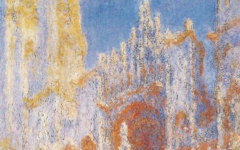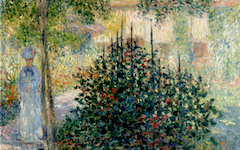Renoir’s Portrait of Monet (1875)
Renoir's study for a well-known portrait of Claude Monet seems like a sketch but it has its own features and interests not present in the more finished work.1
As always, we must try to find out how the artist represented himself. Most obviously, Renoir placed his unusually large signature not in a lower corner, as was traditional, but directly under Monet's figure as though to say: "This is me." Besides, with the horizontal cut below the shoulders, Monet is made to resemble a sculpted bust with an inscription identifying the model, not the artist, underneath. In addition......
Click next thumbnail to continue

Left: Detail of Renoir, Portrait of Monet (c. 1875)
Right: Anon., Detail of photograph of Renoir (c. 1875)
Click image to enlarge.
.....even though Monet's face seems to resemble Monet's portraits and photographs his hairstyle does not. It descends on the left diagonally downwards towards his eyebrow just like Renoir's does in this contemporaneous photograph.
Click next thumbnail to continue

Left: Detail of Renoir, Portrait of Monet (c. 1875)
Right: A Greinier, Photograph of Monet (c.1871)
Click image to enlarge.
As you can see from a typical, slightly earlier, photograph of Monet (right) his hair was short on top, closely cropped and relatively neat. It remained so throughout his life. Thus, although his appearance in Renoir's image might have surprised Monet himself, we are so used to thinking of paintings as historical records (photographs, even) that no-one until now has ever questioned his appearance here.
Click next thumbnail to continue

Left: Detail of Renoir, Portrait of Monet (c. 1875)
Right: Diagram of Renoir, Portrait of Monet (c. 1875)
Click image to enlarge.
And just in case Renoir's large signature beneath Monet's bust and the presence of his own hairstyle were not enough to indicate his alter ego, Renoir also shaped Monet's figure into an R for Renoir. This gave him added reason to cut off Monet's portrait below the shoulders. (See how other artists have also formed images from their own initials in Letters in Art).
See conclusion below
This demonstrates how even a simple portrait can be full of interesting features. To find them, begin by thinking: how can this person be an alter ego of the artist? Secondly, look for what is odd or abnormal, as in the unusual size and placement of the signature. And, thirdly, never take appearances for granted. Just because we think Monet looked like his portrait does not mean that he did. Appearances in art, as in life, deceive, perhaps more so.
Underneath the architecture of Monet's cathedrals is a major surprise

Monet’s Rouen Cathedral (1892-4)
Notes:
1. This study of Monet is in the Simonow Collection, currently on extended view for several years at the Abbaye de Floran in Gers, Southwest France. If you are in the area, it is worth a visit because several of the pictures in the collection have interesting features like this one. We will be adding more examples in the coming months.
Original Publication Date on EPPH: 08 Dec 2010. | Updated: 0. © Simon Abrahams. Articles on this site are the copyright of Simon Abrahams. To use copyrighted material in print or other media for purposes beyond 'fair use', you must obtain permission from the copyright owner. Websites may link to this page without permission (please do) but may not reproduce the material on their own site without crediting Simon Abrahams and EPPH.



